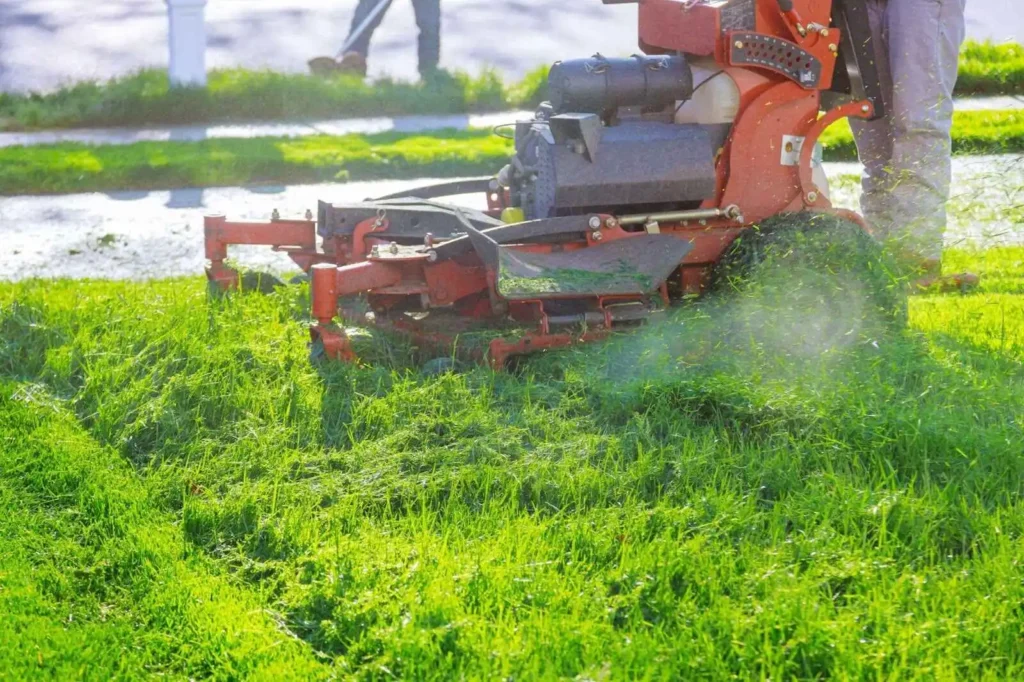Did you know that there’s an optimal time and season to start cutting grass after winter in Ontario, Canada? And did you also know that the height at which you cut your lawn plays a crucial role in its health and appearance?
Now you do.
As a homeowner and senior in Ontario, paying attention to timing and seasonal changes is key to maintaining a beautiful lawn year-round.
It not only enhances your curb appeal but also elevates your home’s aesthetics and potentially increases property value, especially if you’re considering selling or renting soon.
Spring in Ontario brings a renewal of life, but it’s also a critical time for lawn care. The transition from winter dormancy to active growth requires careful handling.
Cutting your grass at the right time ensures that it grows vigorously without stress, leading to a lush and healthy lawn throughout the warmer months.
As such, understanding the dynamics of Ontario’s climate is essential.
For instance, not many people know that frost and soil conditions directly impact when you should start cutting grass after winter.
Professionals like Custodia specialize in Yard Cleanup and Lawn Maintenance in Ontario, offering tailored services to ensure your lawn emerges from winter dormancy beautifully.

By consulting with our lawn care experts near you in Ontario (Click here to Explore our service areas and select your city for fast and professional lawn care and yard maintenance services, among other home management solutions we offer.), you gain insights into local conditions and the best practices for maintaining a resilient lawn.
In this article, we will explore why timing matters in spring lawn care, the potential pitfalls of incorrect timing, and clear signs that indicate it’s time to seek professional advice.
We will also share insider tips on how you can hire the best Yard Cleanup and Lawn Maintenance Service in Ontario to help with cutting grass after winter in Ontario and keep your lawn in pristine condition year-round.
10 Specific Challenges Ontario’s Climate Poses for Lawn Care After Winter

Ontario’s climate presents several unique challenges for maintaining a healthy lawn after winter, affecting both seniors and homeowners alike.
Here’s a comprehensive look at these challenges:
- Frost Heaving
Freezing and thawing cycles can lift shallow-rooted grass, causing root damage and creating uneven surfaces that are hazardous to walk on.
Ensuring proper soil drainage and avoiding heavy foot traffic during thaw periods can mitigate this issue.
- Snow Mold
This fungal disease thrives in cool, moist conditions under snow cover.
It appears as gray or pinkish patches on grass, especially in areas where snow has melted slowly. Raking up debris and improving air circulation in early spring can help prevent snow mold from taking hold.
- Compacted Soil
Winter snow compacts soil, reducing pore space and limiting oxygen and nutrient availability to grass roots. Aerating the lawn in spring helps alleviate compaction and promotes healthy root growth.
- Late Spring Frosts
Frost can damage new growth and tender grass shoots that emerge as temperatures rise. Covering sensitive plants or delaying fertilization until after the last expected frost can protect young grass from frost damage.
- Variable Spring Weather
Rapid temperature changes during spring can stress grass plants, making them more susceptible to diseases like fungal infections.
Proper fertilization and regular watering practices can strengthen grass and improve its resilience.
- Delayed Green-Up
Cool spring temperatures delay the greening of grass, prolonging its dormancy and making lawns appear brown or patchy. Patience and appropriate fertilization can encourage healthy growth once temperatures stabilize.

- Thawing and Refreezing
Alternating periods of thawing and refreezing can lead to soil heaving and create hazards in the lawn. Avoiding heavy equipment or excessive foot traffic during thawing periods can minimize damage.
- Salt Damage
Road salts used for deicing can accumulate in soil, causing salt burn and inhibiting grass growth. Using salt-tolerant grass varieties and rinsing affected areas with water in early spring can mitigate salt damage.
- Spring Flooding
Melting snow and spring rains can saturate soil, leading to waterlogged conditions that suffocate grass roots and promote fungal diseases. Improving soil drainage and avoiding overwatering can prevent these issues.
- Emerging Weeds
Warmer spring temperatures promote the growth of weeds like dandelions and crabgrass, which compete with grass for nutrients and space.
Early weed control measures and proper lawn care practices can suppress weed growth effectively.
Understanding and addressing these challenges is crucial for effective lawn care management in Ontario’s post-winter climate.
Proactive measures such as aerating soil, adjusting fertilization schedules, and monitoring weather conditions can help maintain a healthy and vibrant lawn throughout the year.
Understanding Grass Growth Cycles

Grass growth varies significantly across different seasons, influenced by several key factors that affect its development and dormancy. ’s a detailed look:
Here are factors influencing grass growth in ontario:
- Temperature
Optimal growth occurs when temperatures are moderate, typically between 60-75°F, stimulating active growth phases.
- Daylight Hours
Longer daylight hours in spring and summer provide more energy for photosynthesis, promoting lush growth.
- Moisture Levels
Adequate moisture, balanced with good drainage, supports root development and nutrient uptake, crucial for healthy growth.
- Soil Nutrients
Nutrient-rich soil, supplemented with appropriate fertilization, enhances grass growth and overall lawn health.
- Air Circulation
Proper air circulation around grass blades prevents disease and encourages robust growth.
Importance of Recognizing Grass Dormancy Periods
- Grass enters dormancy during periods of extreme cold or heat, reducing metabolic activity to conserve energy and survive harsh conditions.
- Recognizing dormancy helps adjust lawn care practices, such as reducing mowing frequency and avoiding fertilization, to support grass health and resilience.
- Understanding dormancy periods allows for strategic planning of lawn maintenance activities, ensuring optimal growth and sustainability throughout the year.
Understanding these cycles and factors enables homeowners to plan and adapt their lawn care routines effectively throughout the year, ensuring a vibrant and resilient lawn in every season.
When To Start Cutting Grass After Winter in Ontario, Canada

As winter comes to an end, the transition to spring brings new challenges and opportunities for lawn care.
Knowing the right time to start cutting your grass is crucial for maintaining a healthy and vibrant lawn.
Each season has unique requirements, and timing your first cut after winter can significantly impact your lawn’s health.
Here are five (5) key signs that your lawn is ready to start cutting grass after winter in Ontario.
1. Visible Growth and Greening
Look for new green shoots and blades appearing across your lawn, indicating that the grass is coming out of its dormant state and actively growing.
2. Soil Temperature Readiness
Ensure that the soil temperature is consistently reaching optimal conditions for grass cutting. This typically means waiting until soil temperatures are consistently above 50°F (10°C) for cool-season grasses.
3. Absence of Frost Risks
Check for any lingering frost risks. Cutting grass when there is still a risk of frost can damage tender new growth, so it’s essential to wait until frost is no longer a concern.
4. Dryness of Soil
The soil should be sufficiently dry to allow for a clean cut without clumping. Cutting wet grass can lead to uneven cuts and can also compact the soil.
5. Firmness of Ground
Ensure that the ground is firm enough to support the weight of the mower without causing soil compaction. Mowing on overly wet or soft ground can damage both the lawn and the soil structure.
Lawn Care Tips Post-Winter

Preparing your lawn for spring after the winter months ensures healthy growth and lush greenery.
Here are essential tips to follow:
1. Clear Debris and Prepare the Ground
Remove fallen leaves and branches to allow sunlight to reach the grass and prevent obstruction of air circulation.
2. Rake and Aerate the Soil
Use a rake to loosen compacted soil and improve water absorption. Aeration enhances root health by allowing nutrients to penetrate deeper.
3. Overseed Bare Patches
Spread grass seed over bare spots to promote new growth and fill in gaps for a thicker, healthier lawn.
4. Fertilize for Nutrient Boost
Apply fertilizer to replenish essential nutrients lost during winter, promoting strong and vigorous grass growth.
5. Adjust Mower Height
Set mower blades higher for the first few cuts to avoid stressing new growth and ensure grass is cut to an appropriate length.
6. Monitor Watering Schedule
Water deeply and infrequently to encourage deep root development and ensure the lawn receives adequate moisture.
7. Pest and Weed Control
Address weeds and pests promptly to prevent them from damaging the lawn, maintaining its health and appearance.
Why Hire A Professional Yard Cleanup And Lawn Maintenance In Ontario?
Here are four (4) reasons why seniors may benefit from hiring a professional for lawn care instead of doing it themselves:
- Physical Limitations
Seniors may have limited mobility or strength, making it challenging to perform strenuous lawn care tasks like mowing, raking, or heavy lifting of equipment.
- Expertise and Experience
Professionals bring years of experience and expertise in lawn care techniques, ensuring proper maintenance and treatment tailored to the specific needs of your lawn.
- Time Efficiency
Managing a lawn requires consistent effort and time. By hiring professionals, seniors can save valuable time and energy, allowing them to enjoy other activities and hobbies without the physical strain.
- Safety and Injury Prevention
Professional lawn care providers are trained in safety protocols and use specialized equipment safely. This reduces the risk of accidents or injuries that can occur during DIY lawn care activities.
Choosing to hire a professional for lawn care near you in Ontario allows seniors to maintain a beautiful and safe outdoor environment without the physical demands and potential risks associated with DIY maintenance.
Thankfully, Custodia is always available to assist with yard and lawn maintenance, including cutting grass after winter.
Contact us today at 1-833-410-4357 or book online!
You can also explore our custom and comprehensive home management services tailored to your needs.
Check out our Home Management Plan and pricing to find what works best for your home.




